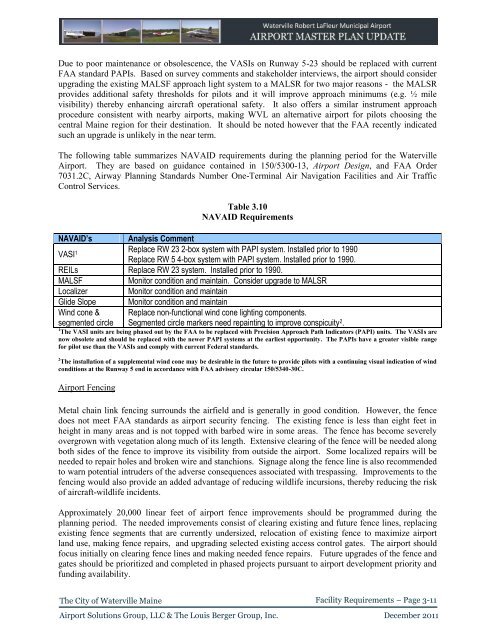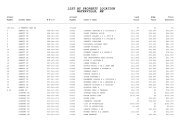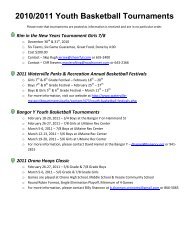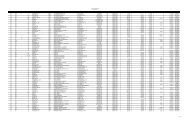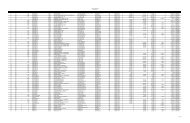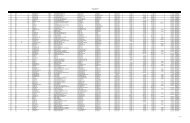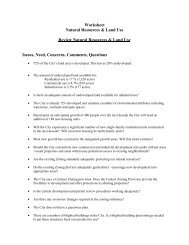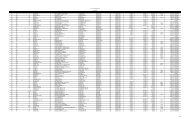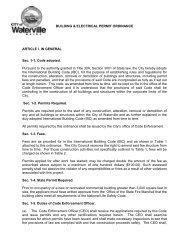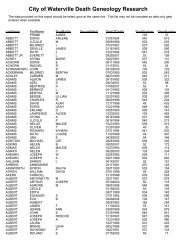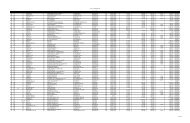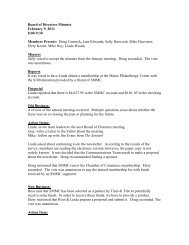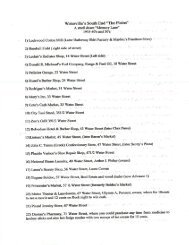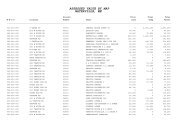Airport Master Plan 2012 - City of Waterville
Airport Master Plan 2012 - City of Waterville
Airport Master Plan 2012 - City of Waterville
Create successful ePaper yourself
Turn your PDF publications into a flip-book with our unique Google optimized e-Paper software.
Due to poor maintenance or obsolescence, the VASIs on Runway 5-23 should be replaced with current<br />
FAA standard PAPIs. Based on survey comments and stakeholder interviews, the airport should consider<br />
upgrading the existing MALSF approach light system to a MALSR for two major reasons - the MALSR<br />
provides additional safety thresholds for pilots and it will improve approach minimums (e.g. ½ mile<br />
visibility) thereby enhancing aircraft operational safety. It also <strong>of</strong>fers a similar instrument approach<br />
procedure consistent with nearby airports, making WVL an alternative airport for pilots choosing the<br />
central Maine region for their destination. It should be noted however that the FAA recently indicated<br />
such an upgrade is unlikely in the near term.<br />
The following table summarizes NAVAID requirements during the planning period for the <strong>Waterville</strong><br />
<strong>Airport</strong>. They are based on guidance contained in 150/5300-13, <strong>Airport</strong> Design, and FAA Order<br />
7031.2C, Airway <strong>Plan</strong>ning Standards Number One-Terminal Air Navigation Facilities and Air Traffic<br />
Control Services.<br />
Table 3.10<br />
NAVAID Requirements<br />
NAVAID’s<br />
Analysis Comment<br />
VASI 1<br />
Replace RW 23 2-box system with PAPI system. Installed prior to 1990<br />
Replace RW 5 4-box system with PAPI system. Installed prior to 1990.<br />
REILs Replace RW 23 system. Installed prior to 1990.<br />
MALSF<br />
Monitor condition and maintain. Consider upgrade to MALSR<br />
Localizer<br />
Monitor condition and maintain<br />
Glide Slope Monitor condition and maintain<br />
Wind cone &<br />
segmented circle<br />
Replace non-functional wind cone lighting components.<br />
Segmented circle markers need repainting to improve conspicuity 2 .<br />
1 The VASI units are being phased out by the FAA to be replaced with Precision Approach Path Indicators (PAPI) units. The VASIs are<br />
now obsolete and should be replaced with the newer PAPI systems at the earliest opportunity. The PAPIs have a greater visible range<br />
for pilot use than the VASIs and comply with current Federal standards.<br />
2 The installation <strong>of</strong> a supplemental wind cone may be desirable in the future to provide pilots with a continuing visual indication <strong>of</strong> wind<br />
conditions at the Runway 5 end in accordance with FAA advisory circular 150/5340-30C.<br />
<strong>Airport</strong> Fencing<br />
Metal chain link fencing surrounds the airfield and is generally in good condition. However, the fence<br />
does not meet FAA standards as airport security fencing. The existing fence is less than eight feet in<br />
height in many areas and is not topped with barbed wire in some areas. The fence has become severely<br />
overgrown with vegetation along much <strong>of</strong> its length. Extensive clearing <strong>of</strong> the fence will be needed along<br />
both sides <strong>of</strong> the fence to improve its visibility from outside the airport. Some localized repairs will be<br />
needed to repair holes and broken wire and stanchions. Signage along the fence line is also recommended<br />
to warn potential intruders <strong>of</strong> the adverse consequences associated with trespassing. Improvements to the<br />
fencing would also provide an added advantage <strong>of</strong> reducing wildlife incursions, thereby reducing the risk<br />
<strong>of</strong> aircraft-wildlife incidents.<br />
Approximately 20,000 linear feet <strong>of</strong> airport fence improvements should be programmed during the<br />
planning period. The needed improvements consist <strong>of</strong> clearing existing and future fence lines, replacing<br />
existing fence segments that are currently undersized, relocation <strong>of</strong> existing fence to maximize airport<br />
land use, making fence repairs, and upgrading selected existing access control gates. The airport should<br />
focus initially on clearing fence lines and making needed fence repairs. Future upgrades <strong>of</strong> the fence and<br />
gates should be prioritized and completed in phased projects pursuant to airport development priority and<br />
funding availability.<br />
The <strong>City</strong> <strong>of</strong> <strong>Waterville</strong> Maine<br />
Facility Requirements – Page 3-11<br />
<strong>Airport</strong> Solutions Group, LLC & The Louis Berger Group, Inc. December 2011


